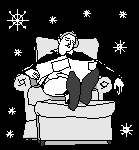

Insomnia
Barbara Dossey, R.N., M.S.
For Hospitalized Patients: Insomnia in the hospital is most often related to
anxiety and fear as the person waits for tests, surgery, or recovery from illness.
It is essential that the health care professional take a sleep history from the
person and help facilitate specific sleep rituals that have worked for that
person prior to hospitalization. It is
also mandatory to have as many uninterrupted 60-90 minute periods of time
to honor the personŐs normal ultradian rhythm along with reducing
extraneous noise. Many studies report that patients are more disturbed by
staff noise than equipment noise.
If patients report not being able to fall asleep or are awakened by worry
thoughts, they can be taught thought-stopping strategies and specific imagery
related to decreasing negative thoughts. Nurses in particular must listen
carefully to what people report about their dreams, because this is part of the
healing process. For example, a man before open heart surgery had dreams of
skulls and cross-bones. His interpretation was to finish some business related
to a pending business deal. Dreams from another patient actually turned out
to be a near-death experience after a cardiac arrest, but the patient didn't have
the language to talk about it. The nurse explained the meaning of the near-
death experience and the patient was able to sleep after the discussion.
Encourage the person to use relaxation, imagery and music prior to sleep to
enhance a sense of control and relaxation. I encourage nurses to develop
specific guided relaxation and imagery tapes related to specific procedures,
tests, and surgery to decrease the worry and fear surrounding upcoming
events so that the person can evoke positive healing imagery and correct
biologic images. It is exciting how use of these tapes significantly reduces the
need for sleep medication during hospitalization.
 General Suggestions:
I find that if I keep my rituals for sleep, most nights I sleep well. I love
taking a hot soaker bath with music playing . . . with very subdued light; it
helps me begin to separate from a busy day. I always spend at least five
minutes or more just soaking in the water and releasing thoughts, doing
nothing but enjoying the soak.
General Suggestions:
I find that if I keep my rituals for sleep, most nights I sleep well. I love
taking a hot soaker bath with music playing . . . with very subdued light; it
helps me begin to separate from a busy day. I always spend at least five
minutes or more just soaking in the water and releasing thoughts, doing
nothing but enjoying the soak.
I keep a stack of art and needlepoint books by my bed. I also have
magazines that have easy delicious recipes in them or creative ideas about
decorating. I have found that reading my professioal journals and books
turns my mind on again and wakes me up.
I lately have been dreaming a lot. I particularly find the twilight period of
time right before sleep comes to be very exciting because recently a stream of
images have been coming which are fascinating. I have a sense of observing
me watching me. I keep a pen and pencil by my bed to jot down ideas from
dreams. My best needlepoint designs have come on awakening during the
night.
When I awake, I find it helpful not to label this waking as insomnia, but
remind myself that my bodymind got in bed because it wanted to sleep. The
most helpful things for me are the relaxation strategy of focusing on the
rhythm of my breath...or the imagery of the hot bath which usually allows me
to return to sleep. I also turn the clock away so that I don't know the time.
Go Back or
Continue on to the next page
 Return to Imagery Techniques
Return to Imagery Techniques


 General Suggestions:
I find that if I keep my rituals for sleep, most nights I sleep well. I love
taking a hot soaker bath with music playing . . . with very subdued light; it
helps me begin to separate from a busy day. I always spend at least five
minutes or more just soaking in the water and releasing thoughts, doing
nothing but enjoying the soak.
General Suggestions:
I find that if I keep my rituals for sleep, most nights I sleep well. I love
taking a hot soaker bath with music playing . . . with very subdued light; it
helps me begin to separate from a busy day. I always spend at least five
minutes or more just soaking in the water and releasing thoughts, doing
nothing but enjoying the soak.